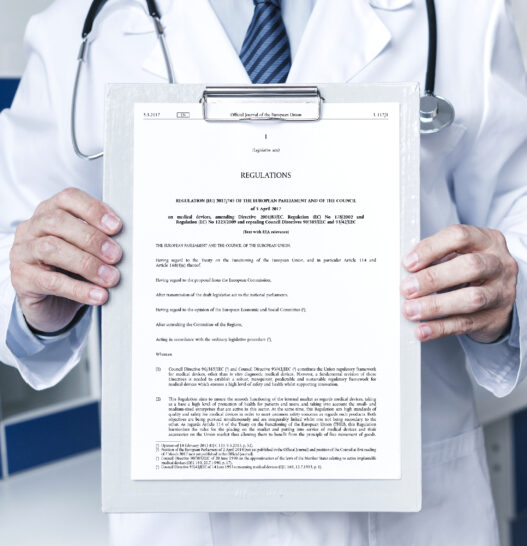What is the MDR?
A new European Medical Device Regulation has been able to replace and reorganise the existing medical device directives, which were in force until 25.05.2017. Therefore, both the Directive 93/42/EEC on medical devices (MDD) and the Directive 90/385/EEC on active implantable medical devices (also known as AIMD) were dropped, as they were incorporated into the new MDR in a modified form. However, the EU regulation on in-vitro diagnostic medical devices (IVD 98/79/EC) offered a special feature, as it was not included in the MDR, but was described separately in the IVDR as of 26.05.2022; it is therefore removed from the existing network. However, the MDD was not simply incorporated into the MDR, but rather a multitude of changed conditions had to be taken into account by the manufacturers, which had to be taken into account from then on when approving products.[3]
The standards have been harmonized as far as possible. All usability aspects are summarized in the IEC 62366-1 standard. In particular, the paragraphs on usability for medical devices have been revised as far as possible and supplemented by some new requirements, for example in the areas of user interfaces, use scenarios and use errors. Learn more about this in our new blog post “the new MDR and its effects on usability”.
Originally, the new MDR was supposed to come into force completely after the transition period on May 26, 2020, and thus the transformation from the MDD to the MDR was supposed to be completed; of course, except for some initial regulations that will have an effect until 2024 and are discussed in the following section. However, the transition originally scheduled for this year (2020) is postponed by another year to 2021. The following figures have already been adjusted.
Details of the postponement
Important in advance: If the manufacturer has a current approval, this remains valid for the time being. If the manufacturer’s certificate was issued to the notified body before 26 May 2017, it will be valid until the date stated in the certificate at the latest. However, it must be noted that certificates are not valid for more than five years and lose their validity on 26 May 2022 at the latest. But what about certificates issued after 26 May 2017? A special passage defines that they lose their validity on 27 May 2024 at the latest, even if the validity date stated on the certificate exceeds this period. In this case, the validity period is shortened and the manufacturer must ensure that a new certificate is issued in good time.[4]
On the other hand, when new medical devices are published, products must be fully compliant with the new MDR as early as 26.05.2021 next year, which means that they must meet all the requirements of the new directive, as the general transition period is over. However, the situation is not quite so dramatic, as the legislator provides for exceptions. If the manufacturer still has a certificate for the product, the deadlines for the certificate (see above) apply; this may apply to products in the previous classes I, IIa, IIb and III. The exception also applies to “Software as Medical Device” products (hereinafter SaMDP) that were put on the market before this date, as these are considered to be Class I (MDD) products and therefore fall under I, IIa, IIb or III in the MDR. However, the SaMDPs must still comply with the requirements of the MDD or AIMD; furthermore, the manufacturer must not have made any significant changes to the product, otherwise it is covered by the MDR and must take their requirements into account. These exceptions will end on 26.05.2024 (i.e. after the end of the now three-year transition period). It is important to note that these exemptions do not concern vigilance and registration of economic operators and products, market surveillance, and post-market surveillance, which must therefore be carried out in accordance with the new MDR.[5]
The deadlines contained in Article 120 (3) of the MDR have been extended by one year, i.e. to 26 May 2021. The effects this has on the certification of manufacturers of medical technology and devices will be explained in more detail below.
What does this mean for medical device manufacturers?
All manufacturers and developers of new medical technology products that are placed on the market after May 26, 2021, should in any case follow the IEC 62366-1 standard, as it describes the current state of the art for usability conformity according to MDR.[6] For all other products developed under the MDD, which are subject to re-authorisation, or legacy products, discrepancies must be identified and actions taken to address them so that they do not hinder compliance with the MDR. Finally, the manufacturer must establish a system for effective post-market surveillance for all products. According to this, especially in the area of usability, the use specification must be revised and adapted to the MDR in order to avoid unnecessary usability tests, and missing use scenarios must be described and assessed for safety relevance; this applies especially to the improvement of the user interface. This also includes the reclassification of products according to risk, contact duration and invasiveness, according to which stricter clinical evidence for Class III medical devices and implantable devices is also to be based.[7] Furthermore, instructions for use must be created or supplemented to ensure that they are MDR-compliant. Not to be neglected is the fact that in future formative and summative evaluations will have to be carried out in order to obtain certification. Finally, the post-market process must be redefined and support the evaluation of future data that can be used to improve the product in order to eliminate weaknesses.[8]
On the one hand, the advantage is obvious: manufacturers have another year to adapt their products to the new requirements. These are formulated more explicitly and leave less room for misconfiguration. On the other hand, the changeover is associated with additional expenditure if products have still been developed under aspects of the MDD, since the additional requirements must now be met.
Conclusion
The MDR is a useful regulatory compendium that harmonises and bundles requirements and regulations. The transition periods, on the other hand, create a lack of transparency: manufacturers run the risk of not meeting their regulatory requirements, which will ultimately mean additional expenditure in product development. In order to prevent this from happening, they must differentiate between facts and accurately assess which ones apply to them. The following questions can be asked: Is it about placing new products and “legacy” products on the market, or simply about the provision and commissioning of products? Are they OEM PLM designs? Who is the responsible person in charge of the evaluation? Is post-market surveillance defined and integrated into the process and can vigilance (increased responsiveness) be achieved even after publication? Can this data be collected in a quality management system? Is the product clearly identifiable (Unique Device Identification)? Are there clinical trials of different types that withstand MDR?[9] You are welcome to ask us your question in the contact form. We will answer it as soon as possible.
Of course, this article cannot cover all exceptions, requirements and conditions, but these can be found in the dossier “REGULATION OF THE EUROPEAN PARLIAMENT AND OF THE COUNCIL concerning medical devices, amending Directive 2001/83/EC, Regulation (EC) No 178/2002 and Regulation (EC) No 1223/2009 and repealing Directives 90/385/EEC and 93/42/EEC“[10] for individual problems are comprehensible, but at the same time also listed in an unclear manner. However, it is important to assess one’s own situation, since the requirements of the new regulation also apply to products that have already been approved and published in accordance with the old conditions. If this has not already been done, manufacturers should use the remaining year to approve their new products under the MDR. Custom Medical will be happy to provide you with competent advice on this.
Bibliography:
[1] Ordinance on medical devices: Commission presents proposal for a later date of application, Gesundheitsindustrie BW https://www.gesundheitsindustrie-bw.de/fachbeitrag/pm/verordnung-ueber-medizinprodukte-kommission-legt-vorschlag-zu-spaeterem-geltungsbeginn-vor
[2] Proposal for a Regulation of the European Parliament and of the Council amending Regulation (EU) 2017/745 on medical devices as regards the dates of application of certain of its provisions, Council oft he European Union https://eur-lex.europa.eu/legal-content/EN/TXT/PDF/?uri=CONSIL:ST_7180_2020_INIT&from=EN&utm_source=mailing&utm_campaign=200415-NL-internationale-Zulassung
[3] MDR: Transitional periods not without pitfalls, VDE Health https://www.vde.com/topics-de/health/aktuelles/mdr-uebergangsfristen
[4] EU-MEDIZINPRODUKTEVERORDNUNG (MDR), TÜV Süd https://www.tuvsud.com/de-de/branchen/gesundheit-und-medizintechnik/marktzulassung-und-zertifizierung-von-medizinprodukten/mdr-medizinprodukteverordnung-eu
[5] EU Dossier MDR, Council of the European Union http://data.consilium.europa.eu/doc/document/ST-10728-2016-INIT/DE/pdf
[6] IEC 62366-1:2015 News about the Usability Norm, Johner https://www.johner-institut.de/blog/iec-62366-usability/iec-62366-1-2015/
[7] EU MEDICAL DEVICE REGULATION (MDR), TÜV Süd https://www.tuvsud.com/de-de/branchen/gesundheit-und-medizintechnik/marktzulassung-und-zertifizierung-von-medizinprodukten/mdr-medizinprodukteverordnung-eu
[8] Usability requirements of the MDR, Johner Institut https://www.johner-institut.de/blog/regulatory-affairs/anforderungen-der-mdr-an-die-usability/
[9] Medical devices New EU regulations, German Federal Ministry of Health https://www.bundesgesundheitsministerium.de/themen/gesundheitswesen/medizinprodukte/neue-eu-verordnungen.html
[10] EU Dossier MDR, Council of the European Union http://data.consilium.europa.eu/doc/document/ST-10728-2016-INIT/DE/pdf



